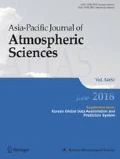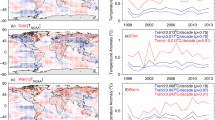Abstract
Version 6 of the UAH MSU/AMSU global satellite temperature dataset represents an extensive revision of the procedures employed in previous versions of the UAH datasets. The two most significant results from an end-user perspective are (1) a decrease in the global-average lower tropospheric temperature (LT) trend from +0.14°C decade−1 to +0.11°C decade−1 (Jan. 1979 through Dec. 2015); and (2) the geographic distribution of the LT trends, including higher spatial resolution, owing to a new method for computing LT. We describe the major changes in processing strategy, including a new method for monthly gridpoint averaging which uses all of the footprint data yet eliminates the need for limb correction; a new multi-channel (rather than multi-angle) method for computing the lower tropospheric (LT) temperature product which requires an additional tropopause (TP) channel to be used; and a new empirical method for diurnal drift correction. We show results for LT, the midtroposphere (MT, from MSU2/AMSU5), and lower stratosphere (LS, from MSU4/AMSU9). A 0.03°C decade−1 reduction in the global LT trend from the Version 5.6 product is partly due to lesser sensitivity of the new LT to land surface skin temperature (est. 0.01°C decade−1), with the remainder of the reduction (0.02°C decade−1) due to the new diurnal drift adjustment, the more robust method of LT calculation, and other changes in processing procedures.
Similar content being viewed by others
References
Adler, R. F., and Coauthors, 2003: The version 2 global precipitation climatology project (GPCP) monthly precipitation analysis (1979-Present). J. Hydrometeorol., 4, 1147–1167, doi:10.1175/1525-7541(2003)004<1147:TVGPCP>2.0.CO;2.
Christy, J. R., R. W. Spencer, and W. D. Braswell, 2000: MSU tropospheric temperatures: Dataset construction and radiosonde comparisons. J. Atmos. Ocean. Tech., 17, 1153–1170, doi:10.1175/1520-0426(2000) 017<1153:MTTDCA>2.0.CO;2.
Conrath, B. J., 1972: Vertical resolution of temperature profiles obtained from remote radiation measurements. J. Atmos. Sci., 29, 1262–1271, doi:10.1175/1520-0469(1972)029<1262:VROTPO>2.0.CO;2.
Dee, D. P., and Coauthors, 2011: The ERA-Interim reanalysis: configuration and performance of the data assimilation system. Quart. J. Roy. Meteor. Soc., 137, 553–597, doi:10.1002/qj.828
Free, M., and D. J. Seidel, 2005: Causes of differing temperature trends in radiosonde upper air datasets. J. Geophys. Res., 110, D07101, doi: 10.1029/2004JD005481.
Free, M., D. J. Seidel, J. K. Angell, J. Lanzante, I. Durre, and T. C. Peterson, 2005: Radiosonde Atmospheric Temperature Products for Assessing Climate (RATPAC): A new data set of large-area anomaly time series. J. Geophys. Res., 110, D22101, doi:10.1029/2005JD006169
Fu, Q., C. M. Johanson, S. G. Warren, and D. J. Seidel, 2004: Contribution of stratospheric cooling to satellite-inferred tropospheric temperature trends. Nature, 429, 55–58, doi:10.1038/nature02524.
Haimberger, L., 2007: Homogenization of radiosonde temperature time series using innovation statistics. J. Climate, 20, 1377–1403, doi:10. 1175/JCLI4050.1.
Haimberger, L., C. Tavolato, and S. Sperka, 2012: Homogenization of the global radiosonde temperature dataset through combined comparison with reanalysis background series and neighboring stations. J. Climate, 25, 8108–8131, doi:10.1175/JCLI-D-11-00668.1.
Lu, Q., and W. Bell, 2014: Characterizing channel center frequencies in AMSU-A and MSU Microwave Sounding Instruments. J. Atmos. Ocean. Tech., 31, 1713–1732, doi:10.1175/JTECH-D-13-00136.1.
Mears, C. A., M. C. Schabel, and F. J. Wentz, 2003: A reanalysis of the MSU channel 2 tropospheric temperature record. J. Climate, 16, 3650–3664, doi:10.1175/1520-0442(2003)016<3650:AROTMC>2.0.CO;2.
Mears, C. A., F. J. Wentz, and P. W. Thorne, 2012: Assessing the value of Microwave Sounding Unit radiosonde comparisons in ascertaining errors in climate data records of tropospheric temperatures. J. Geophys. Res., 117, D19103, doi:10.1029/2012JD017710.
Robel, J., and A. Graumann, 2014: NOAA KLM User’s Guide with NOAA-N, N Prime, and Metop Supplements. NOAA/NESDIS/NCDC, Asheville, NC,2530 pp.
Po-Chedley, S., and Q. Fu, 2012: A bias in the midtropospheric channel warm target factor on the NOAA-9 Microwave Sounding Unit. J. Atmos. Ocean. Tech., 29, 646–652, doi:10.1175/JTECH-D-11-00147.1.
Po-Chedley, S., T. J. Thorsen, and Q. Fu, 2015: Removing diurnal cycle contamination in satellite-derived tropospheric temperatures: Understanding tropical tropospheric trend discrepancies. J. Climate, 28, 2274–2290, doi:10.1175/JCLI-D-13-00767.1.
Sherwood, S. C., and N. Nishant, 2015: Atmospheric changes through 2012 as shown by iteratively homogenised radiosonde temperature and wind data (IUKv2). Env. Res. Lett., 10, 054007, doi:10.1088/1748-9326/10/5/054007
Spencer, R. W., and J. R. Christy, 1990: Precise monitoring of global temperature trends from satellites. Science, 247, 1558–1562, doi:10. 1126/science.247.4950.1558
Spencer, R. W., and J. R. Christy, 1992a: Precision and radiosonde validation of satellite gridpoint temperature anomalies, Part I: MSU channel 2. J. Climate, 5, 847–857, doi:10.1175/1520-0442(1992)005<0847:PARVOS> 2.0.CO;2.
Spencer, R. W., and J. R. Christy, 1992b: Precision and radiosonde validation of satellite gridpoint temperature anomalies, Part II: A tropospheric retrieval and trends during 1979-90. J. Climate, 5, 858–866, doi:10. 1175/1520-0442(1992)005<0858:PARVOS>2.0.CO;2.
Spencer, R. W., and J. R. Christy, 1993: Precision lower stratospheric temperature monitoring with the MSU: Technique, validation, and results 1979-91. J. Climate, 6, 1301–1326, doi:10.1175/1520-0442(1993)006<1194: PLSTMW>2.0.CO;2.
Titchner, H. A., P. W. Thorne, M. P. McCarthy, S. F. B. Tett, L. Haimberger, and D. E. Parker, 2009: Critically reassessing tropospheric temperature trends from radiosondes using realistic validation experiments. J. Climate, 22, 465–485, doi:10.1175/2008JCLI2419.1.
Wentz, F. J., and M. Schabel, 1998: Effects of orbit decay on satellitederived lower-tropospheric temperature trends. Nature, 394, 661–664, doi:10.1038/29267
Zou, C.-Z., and W. Wang, 2011: Inter-satellite calibration of AMSU-A observations for weather and climate applications. J. Geophys. Res., 116, D23113, doi:10.1029/2011JD016205.
Author information
Authors and Affiliations
Corresponding author
Rights and permissions
About this article
Cite this article
Spencer, R.W., Christy, J.R. & Braswell, W.D. UAH Version 6 global satellite temperature products: Methodology and results. Asia-Pacific J Atmos Sci 53, 121–130 (2017). https://doi.org/10.1007/s13143-017-0010-y
Received:
Accepted:
Published:
Issue Date:
DOI: https://doi.org/10.1007/s13143-017-0010-y




